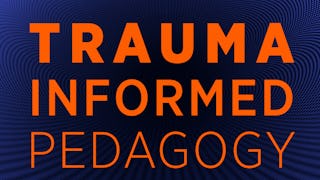This course imparts a wide range of basic knowledge and skills in the field of trauma surgical and orthopedic treatment of patients. To facilitate this, the course employs a new concept of information transfer. We follow a scientific approach and a sophisticated combination of modern teaching methods to vividly impart the taught contents. This included case-based learning, comprehensive factual knowledge, and consecutive quizzes, which help to better memorize the learned contents and later employ them in everyday situations in the field of trauma surgery.



(234 avis)
Expérience recommandée
Ce que vous apprendrez
Trauma mechanisms and their sequelae
Fracture localization
Fracture classification
Fracture treatment according to gold standard
Détails à connaître

Ajouter à votre profil LinkedIn
12 devoirs
Découvrez comment les employés des entreprises prestigieuses maîtrisent des compétences recherchées


Obtenez un certificat professionnel
Ajoutez cette qualification à votre profil LinkedIn ou à votre CV
Partagez-le sur les réseaux sociaux et dans votre évaluation de performance

Il y a 6 modules dans ce cours
The first part of this module is attended to familiarize the participants with the management of polytraumatized patients. They will learn about the operational procedure in a trauma room and get to know the ATLS algorithm. This standardized algorithm that is used all over the world is based on the ABCDE scheme that will be explained to you in detail. It is intended to structure complex life-threatening injuries and help you enable the survival of your patient. In the second part of this module, attendees will be introduced to the principles of fracture management. They will not only learn about bone structure and its function, but also acquire knowledge about the classification of fractures. They will get to know the three principles of conservative and operative treatment which are reduction, fixation and rehabilitation. Therefore, particular attention will be paid to the different modes of osteosynthesis. The third part of this module is the introduction to our tutorial regarding the upper extremity. In the third episode, participants will learn about clavicle fractures. First, they will be familiarized with the anatomy of the clavicle and the classification of its fractures. Subsequently, they will get to know the different injury mechanisms, the correct diagnostic investigation and figure out the right mode of therapy. Thereby, the dreaded complication of pseudarthroses will also be elaborated on. The fourth and last episode of this module is about humeral head fractures. First of all, attendees will recapitulate the most important anatomical principles. They will be acquainted with the most common classification according to Neer. The aim is to help them making therapeutical decisions which include non-operative options and operative treatment with plates or prostheses.
Inclus
4 vidéos2 devoirs
In our second module, participants will first be taught about humeral shaft fractures. Afterwards, the second part covers the field of elbow fractures. Both videos follow the same order: After learning about the basic anatomical principles, participants will be encouraged to study the epidemiology and classification of the different fractures. They will learn about the right diagnostic investigation and subsequently, they will be familiarized with the indications for different treatment options including both non-operative and surgical alternatives. In the second part of this module regarding the upper extremity, two more bone fractures will be brought closer to the participant: fractures of the distal radius, the most common fracture in human beings, as well as metacarpal fractures. Regarding fractures of the distal radius, participants will first of all repeat the basic anatomical principles. Subsequently, they will learn about the classification of those kinds of fractures, the right diagnostic investigation as well as the non-operative vs. surgical treatment options and the follow-up treatment. In terms of metacarpal fractures, participants will first of all get to know the anatomical principles, particularly the different localizations of fractures, which affect the chosen treatment and other aspects.
Inclus
4 vidéos2 devoirs
The first part of this tutorial is about two main pathologies of the hand in traumatology. In the first video, participants will learn about the anatomical principles of the scaphoid bone as well as the epidemiology of its fractures. Subsequently, they will be familiarized with its classification and the particular treatment. The second episode covers ruptures of the extensor tendon in the hand. Just like in the other modules of the Basics of Trauma Surgery, this course starts with an anatomic introduction to the localization, followed by epidemiologic explanations of the state-of-the-art treatment of injuries to this region. In the second part of this module, participants will primarily study fractures of the thoracic and lumbar spine followed by cervical spine injuries. They should envision the anatomy of the spine and the epidemiology as well as the most common injury mechanisms of related fractures. Participants should attach great importance to the clinical-neurological examination. They will be familiarized with both the vertebra model according to Denis and the classification according to Magerl for fractures of the thoracic and lumbar spine as well as a classification for injuries of the upper cervical spine. Different treatment options are presented, e.g. by ventral or dorsal stabilization. The fourth and last video of this module is about pelvic injuries. After explaining the basic anatomical principles and the danger of hemorrhage, participants will be familiarized with the epidemiology and classification of pelvic ring fractures. Furthermore, different treatment options will be highlighted.
Inclus
4 vidéos2 devoirs
In this module, participants will learn about fractures of the femur. The first video is about fractures of the proximal femur that can be subdivided into fractures of the head and neck as well as pertrochanteric and subtrochanteric fractures. Especially the blood supply of the proximal femur is a crucial concern in fractures. Different treatment objectives and options are therefore highlighted. The second video continues with fractures of the femoral shaft. Participants will learn about the basic anatomical principles and their consequences for fractures of this area. After getting to know the epidemiology of femoral shaft fractures and their underlying accident mechanism, different options for operative treatment are presented. In the second part of the module, participants will learn about two more main traumatological pathologies of the lower extremity. The third video is about fractures of the ankle joint. After getting to know the basic anatomy and the trauma mechanism, participants should internalize the classification, which is important for the further procedure. In addition, the clinical and radiological examination will be highlighted.
Inclus
3 vidéos2 devoirs
The first part of this module is about tibial head fractures. Analogous to the preceding modules, the anatomical basics are covered first. Furthermore, there is an introduction to the classifications of this type of fracture. The participants will subsequently learn about the correct diagnostic examination as well as the different treatment options, conservative and surgical measures as well as adequate follow-up schemes. Afterwards, the module treats two further very common entities in traumatology: traumatic brain injury (TBI) and cut wounds and their treatment by means of adequate wound suture. Just like in the other modules, we first focus on the introduction of the anatomy of the skull and afterwards, accident mechanisms of this body region are shown. Subsequently, details on the particular risks associated to head injuries are provided and how these dangerous consequences of an accident can be treated correctly. In the last part of the module, we finally cover cut injuries and their treatment by means of wound suture. Like before, we first introduce possible injury mechanisms, followed by the state-of-the-art treatment of these injuries.
Inclus
3 vidéos2 devoirs
In this final module of our course, we initially address two further common everyday injury mechanisms: bite wounds, which can for example be caused by animal bites and which are often underestimated. This is particularly dangerous, as they can be associated with serious infections. First, we focus on the incidence of these injuries and subsequently on the correct treatment by means of wound suture and antibiotics. The second video of the module covers burn injuries, which are injuries that can also occur unexpectedly every day, for example as a result of mishaps in the kitchen. Initially, we outline the basics of burn injuries, followed by a detailed description of wound management of this particular traumatic entity. In the final teaching unit of the Basics of Trauma Surgery of TUM, we detail on a dangerous injury pattern: penetrating injuries to the thorax. Just like in the preceding modules, this unit starts with an epidemiologic classification and the basics of these often life-endangering injuries. The course eventually closes with a detailed explanation of the necessary imaging and correct therapeutic options, which are indispensable to ensure survival and satisfactory recovery of the affected patients.
Inclus
3 vidéos2 devoirs
Instructeur

Offert par
En savoir plus sur Patient Care


University of Colorado System


University of Illinois Urbana-Champaign


Johns Hopkins University


Yale University
Pour quelles raisons les étudiants sur Coursera nous choisissent-ils pour leur carrière ?




Avis des étudiants
234 avis
- 5 stars
70,51 %
- 4 stars
19,65 %
- 3 stars
5,12 %
- 2 stars
2,13 %
- 1 star
2,56 %
Affichage de 3 sur 234
Révisé le 3 août 2021
Some of the content was not translated into English. And subtitles for the videos were off, making it hard to follow!
Otherwise, really informative and well-made online course!
Révisé le 26 avr. 2020
Helped me a lot and was particularly useful to me as i will be starting my orthopaedic residency within a month!!!
Révisé le 30 avr. 2022
Tons of information. English subtitles sometimes don't synchronize with spoken German. But, a useful course that is very well produced.

Ouvrez de nouvelles portes avec Coursera Plus
Accès illimité à 10,000+ cours de niveau international, projets pratiques et programmes de certification prêts à l'emploi - tous inclus dans votre abonnement.
Faites progresser votre carrière avec un diplôme en ligne
Obtenez un diplôme auprès d’universités de renommée mondiale - 100 % en ligne
Rejoignez plus de 3 400 entreprises mondiales qui ont choisi Coursera pour les affaires
Améliorez les compétences de vos employés pour exceller dans l’économie numérique
Foire Aux Questions
Access to lectures and assignments depends on your type of enrollment. If you take a course in audit mode, you will be able to see most course materials for free. To access graded assignments and to earn a Certificate, you will need to purchase the Certificate experience, during or after your audit. If you don't see the audit option:
The course may not offer an audit option. You can try a Free Trial instead, or apply for Financial Aid.
The course may offer 'Full Course, No Certificate' instead. This option lets you see all course materials, submit required assessments, and get a final grade. This also means that you will not be able to purchase a Certificate experience.
When you purchase a Certificate you get access to all course materials, including graded assignments. Upon completing the course, your electronic Certificate will be added to your Accomplishments page - from there, you can print your Certificate or add it to your LinkedIn profile. If you only want to read and view the course content, you can audit the course for free.
You will be eligible for a full refund until two weeks after your payment date, or (for courses that have just launched) until two weeks after the first session of the course begins, whichever is later. You cannot receive a refund once you’ve earned a Course Certificate, even if you complete the course within the two-week refund period. See our full refund policy.
Plus de questions
Aide financière disponible,


